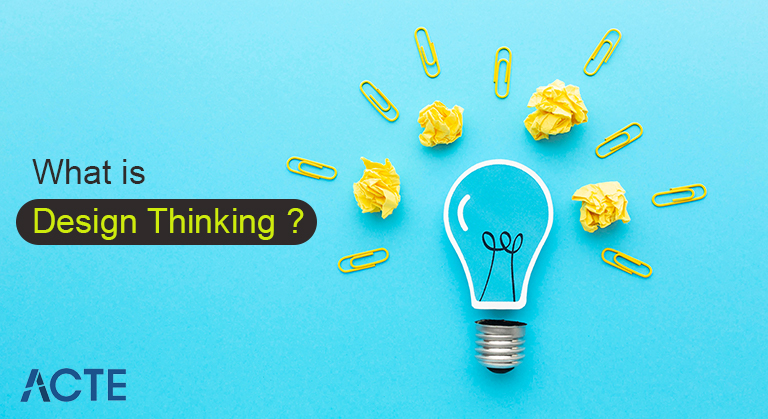
What is Design Thinking ? : Benefits and Special Features | A Definitive Guide with Best Practices
Last updated on 28th Dec 2021, Blog, General
Design thinking is a process for solving problems by prioritizing the consumer’s needs above all else. It relies on observing, with empathy, how people interact with their environments, and employs an iterative, hands-on approach to creating innovative solutions.
- Introduction to Design Thinking
- Why Is Design Thinking so Important?
- The Five Stages of Design Thinking
- The Problem with Ingrained Patterns of Thinking
- An Example of Problem solving: The Encumbered Vs. The Fresh Mind
- Design Thinking or ‘Outside the Box’ Thinking
- Design Thinking is an Essential Tool – and A Third Way
- Science and Rationality in Design Thinking
- Benefits of Design Thinking
- Conclusion
- Design thinking is a non-linear, iterative process that teams use to understand users, challenge assumptions, redefine problems, and create innovative solutions for prototyping and testing. Involving five phases – empathise, define, consider, prototyping and testing – it is most useful for dealing with problems that are undefined or unknown.
- Design Thinking is an iterative process in which we attempt to identify alternative strategies and solutions to understand the user, challenge assumptions, and redefine problems that may not be immediately apparent with our initial level of understanding Huh. Also, Design Thinking provides a solution-based approach to solving problems. It is a way of thinking and working as well as a collection of practical methods.
- Design thinking revolves around a keen interest in developing an understanding of the people for whom we are designing the products or services. It helps us to see and develop empathy with the target user. Design thinking helps us in the process of asking questions: questioning the problem, questioning the assumptions, and questioning the implications. Design thinking is extremely useful for tackling non-defined or unknown problems by re-framing the problem in human-centred ways, building up multiple ideas in brainstorming sessions, and adopting a practical approach in prototyping and testing. Design thinking also includes ongoing experimentation: sketching, prototyping, testing and trying out concepts and ideas.
Introduction to Design Thinking:
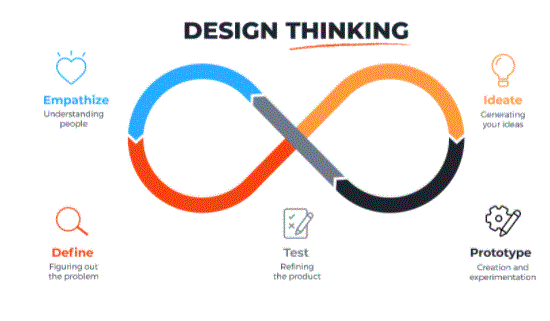
- In user experience (UX) design, it is important to develop and refine the skills to understand and address rapid changes in users’ environments and behaviour. The world has become increasingly interconnected and complex since cognitive scientist and Nobel laureate Herbert A. Simon. Simon first mentioned design thinking in his 1969 book The Science of the Artificial and then contributed several ideas to its principles. Professionals from various fields, including architecture and engineering, later carried on this highly creative process to meet human needs in the modern era.
- Twenty-first century organisations from a wide range of industries find design thinking a valuable tool for problem-solving for users of their products and services. Design teams use design thinking to tackle mis-defined/unknown problems (aka rogue problems) because they can reframe these in human-centred ways and focus on what matters most to users . In all design processes, design thinking is almost certainly best to “think outside the box”. With it, teams can conduct improved UX research, prototyping and usability testing to uncover new ways to meet users’ needs.
- The value of design thinking as a world-improving, driving force in business (with global giants such as Google, Apple and Airbnb bringing it to remarkable influence) is matched by its status as a popular subject at major international universities. With Design Thinking, teams have the freedom to generate unprecedented solutions. Using it, your team can gain hard-to-reach insights and apply a collection of practical methods to help find innovative answers.
Why Is Design Thinking so Important?
The Five Stages of Design Thinking:
The Hasso Plattner Institute of Design (aka D.School) at Stanford describes design thinking as a five-stage process. Note: These steps are not always sequential, and teams often run them out of sequence, in parallel, and repeat them in an iterative fashion:
Step 1: Empathy—Research Your Users’ Needs – Here, you should gain a sympathetic understanding of the problem you are trying to solve, usually through user research. Empathy is important to a human-centred design process like design thinking because it allows you to set aside your perceptions of the world and gain real insight into users and their needs.
Step 2: Define—Describe your users’ needs and problems– It is time to accumulate the information gathered during the empathy phase. You then analyse and synthesise your observations to define the main problems that you and your team have identified. These definitions are called problem statements. You can create personas to help keep your efforts human-centred before moving on to ideology.
Step 3: Think – Challenge assumptions and create ideas– Now, you are ready to generate ideas. A solid background of knowledge from the first two steps means you can begin to “think outside the box”, seek alternative ways of looking at the problem and identify innovative solutions to the problem statement you have created . Brainstorming is especially useful here.
Step 4: Prototype—Start Building the Solution– This is an experimental phase. The aim is to identify the best possible solution for each problem found. Your team must produce some cheap, small-scale versions of the product (or unique features found within the product) to examine the ideas you generate. This may only involve paper prototyping.
Step 5: Test—Try Your Solutions– The evaluators rigorously test the prototypes. Although this is the final step, design thinking is iterative: teams often use the results to redefine one or more problems. Therefore, you can return to the previous steps to make further iterations, changes and refinements – to find or rule out alternative solutions. Overall, you should understand that these phases are separate ways that contribute to the entire design project, rather than successive phases. Your goal is to gain a deeper understanding of time users and what their ideal solution/product would be
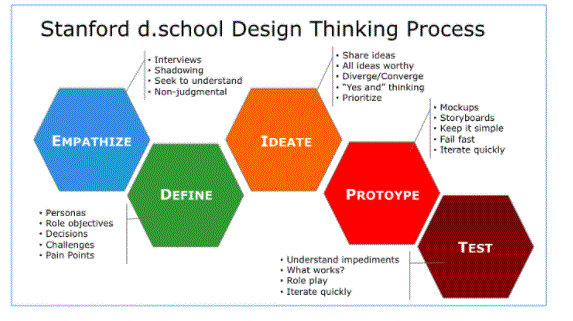
- Sometimes, the easiest way to understand something abstract, such as design thinking, is to understand what it is not. Humans naturally develop patterns of thinking based on repetitive activities and commonly acquired knowledge. These help us quickly apply similar tasks and knowledge to similar or familiar situations, but they also have the ability to prevent us from quickly and easily accessing or developing new ways of looking, understanding, and solving problems.
- These patterns of thinking are often referred to as schemas, which are organised sets of information and relationships between things, actions, and ideas that are stimulated and initiated in the human mind when we are exposed to certain environmental stimuli.
- A single schema can contain a large amount of information. For example, we have a schema for dogs that includes the presence of four legs, fur, sharp teeth, a tail, claws and many other conceivable features.
- When environmental stimuli match this schema—even if there is a weak link or only certain characteristics are present—the same pattern of thought is brought to the mind. Since these schemas are automatically driven, this can inhibit the more appropriate effect of the situation or prevent us from viewing a problem in a way that would enable a new problem-solving strategy. Innovative problem solving is also known as “thinking outside the box”.
The Problem with Ingrained Patterns of Thinking:
- Thinking out-of-the-box can lead to an innovative solution to a sticky problem. However, thinking out of the box can be a real challenge because we naturally develop thinking patterns that are based on repetitive activities and gain access to the knowledge we are usually surrounded by.
- A few years back there was an incident where a truck driver tried to pass under a low bridge. But that failed, and the truck was buried firmly under the bridge. The driver was unable to continue driving forwards or backwards.
- The story goes that as soon as the truck got stuck, it caused a massive traffic problem, resulting in emergency personnel, engineers, firefighters and truck drivers gathered to devise and negotiate various solutions to remove the stranded vehicle. Had to be
- Emergency workers were debating whether to dismantle parts of the truck or cut off parts of the bridge. Each talked about a solution that fits within their respective level of expertise.
- Seeing the heated argument, a running boy looked at the truck over the bridge, then looked at the road and said carelessly, “Why not just let the air out of the tires?” To the complete amazement of all the experts and experts trying to fix the problem.
- When the solution was tested, the truck was able to drive freely, only to be damaged by its initial attempt to pass under the bridge. The story embodies the struggles we face, where often the most obvious solutions are the most difficult, as we work through the constraints imposed by ourselves.
- It is often difficult for us humans to challenge our perceptions and everyday knowledge, as we rely on building patterns of thinking to learn everything from scratch each time. We rely on ourselves to perform everyday processes more or less unconsciously – for example, when we wake up in the morning, eat, walk and read – but even when we assess challenges at work and in our personal lives . In particular, experts and experts rely on their solid thought patterns, and it can be very challenging and difficult for experts to begin to question their knowledge.
An Example of Problem solving: The Encumbered Vs. The Fresh Mind:
- Design thinking is often referred to as ‘outside the box’ thinking, as designers are attempting to develop new ways of thinking that do not follow the dominant or more common problem-solving methods.
- At the heart of Design Thinking is the intention to improve products by analysing and understanding how users interact with products and examining the conditions in which they operate. At the heart of design thinking lies the interest and ability to ask important questions and challenge assumptions.
- One element of outside the box thinking is to falsify previous assumptions – that is, it is possible to prove whether or not they are valid. Once we have questioned and examined the state of a problem, the solution-building process will help us generate ideas that reflect the real constraints and aspects of that particular problem. Design Thinking gives us a means to dig into that depth; This helps us conduct the right kind of research and prototype and test our products and services to uncover new ways to improve a product, service or design.
Design Thinking or ‘Outside the Box’ Thinking:
- The design process often involves many different groups of people in different departments; For this reason, it can be difficult to develop, classify, and organise ideas and problem solutions. One way to keep a design project on track and organise original ideas is to use a design thinking approach.
- Tim Brown, CEO of renowned innovation and design firm IDEO, shows in his breakthrough book Change by Design that Design Thinking is strongly based on creating a holistic and empathetic understanding of people’s problems, and includes vague or inherently subjective concepts. Such as emotions, needs, motivations and drivers of behaviour.
- This is in contrast to a completely scientific approach, where there is a greater distance in the process of understanding and testing user needs and feelings – for example, through quantitative research. Tim Brown stated that Design Thinking is a third approach: Design Thinking is essentially a problem-solving approach, crystallised in the field of design, that combines rational and analytical research with the goal of creating innovative solutions that combine a holistic user- Combines focused perspective.
Design Thinking is an Essential Tool – and A Third Way:
- Some scientific activities would include analysing how users interact with products and examining the conditions in which they operate: researching user needs, gaining experience from past projects, presenting specific to the product and considering future situations, testing the parameters of the problem, and testing the practical application of alternative problem solving.
- Unlike a purely scientific approach, where most of the known properties, characteristics, etc. of the problem are tested to arrive at a solution to a problem, design thinking investigates to reveal previously unknown parameters and uncover alternative strategies. There are ambiguous elements of the problem involved.
- After arriving at a number of possible problem solutions, the selection process is based on rationality. Designers are encouraged to analyse and falsify these problem solutions to arrive at the best available alternative for each problem or constraint identified during each step of the design process.
- With this in mind, it may be more correct to say that design thinking is not about thinking outside the box, but about its sides, its corners, its flaps and its barcode, as Clint Runge said.
Science and Rationality in Design Thinking:
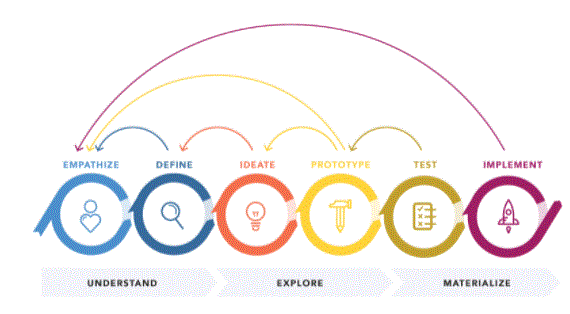
- Design Thinking Process How can design thinking benefit or apply to you? The philosophy of “design, test and iterate” is at the heart of the process.
- This allows you to achieve those completely unexpected successes by creating multiple rapid prototypes and encouraging rapid feedback from real users and customers before spending too much time, effort or money on a single idea.
- With an emphasis on problem-solving and finding viable solutions, Design Thinking can significantly reduce the time spent on design and development. As human beings, we rely on accumulated knowledge and experiences to inform our actions. We form patterns and habits that, while useful in certain situations, can limit our view of things when it comes to problem-solving.
- Design Thinking Process How can design thinking benefit or apply to you? The philosophy of “design, test and iterate” is at the heart of the process.
- This allows you to achieve those completely unexpected successes by creating multiple rapid prototypes and encouraging rapid feedback from real users and customers before spending too much time, effort or money on a single idea.
- With an emphasis on problem-solving and finding viable solutions, Design Thinking can significantly reduce the time spent on design and development. Rather than repeating similar tried-and-tested methods, design thinking encourages us to ditch our blinkers and consider alternative solutions.
- Design Thinking Process How can design thinking benefit or apply to you? The philosophy of “design, test and iterate” is at the heart of the process.
- This allows you to achieve those completely unexpected successes by creating multiple rapid prototypes and encouraging rapid feedback from real users and customers before spending too much time, effort or money on a single idea.
- With an emphasis on problem-solving and finding viable solutions, Design Thinking can significantly reduce the time spent on design and development. The entire process lends itself to challenging assumptions and established beliefs, encouraging all stakeholders to think outside the box, exploring new avenues and ideas. It fosters a culture of creativity and innovation.
- Design Thinking Process How can design thinking benefit or apply to you? The philosophy of “design, test and iterate” is at the heart of the process.
- This allows you to achieve those completely unexpected successes by creating multiple rapid prototypes and encouraging rapid feedback from real users and customers before spending too much time, effort or money on a single idea.
- With an emphasis on problem-solving and finding viable solutions, Design Thinking can significantly reduce the time spent on design and development.
- Design Thinking Process How can design thinking benefit or apply to you? Bringing successful products to market faster ultimately saves the business money. Design thinking has been proven to deliver a significant return on investment; For example, teams implementing IBM’s design thinking practises have calculated ROIs of up to 300% as a result.
- A recent McKinsey study identified significant financial benefits of a human-centred design approach: 32% higher revenue and 56% higher total return. This comprehensive study shows that there can be significant financial, measurable results and ROI that results from a coherent Design Thinking approach to business.
- Design Thinking Process How can design thinking benefit or apply to you? The foundation of design thinking is empathy. Sometimes referred to as “discovery”, empathy requires that we try to understand and identify people’s needs and challenges), experience.
- By focusing so heavily on empathy, it encourages businesses and organisations to consider the real people who use their products and services – meaning their mark when it comes to creating meaningful user experiences. But there is a higher chance of getting hit. For the user, this means better, more useful products that actually make our lives better. For businesses, this means happy customers and a healthy bottom line.
- Design thinking ensures a user-centric approach, which ultimately increases user engagement and customer retention in the long term. The goal is to develop useful products and solutions that meet user needs, to see where their frustration lies and how we can make their lives and experiences better and more fulfilling.
- Design Thinking Process How can design thinking benefit or apply to you? Design Thinking is not just creativity and innovation for its own sake; It is specifically directed towards creating value and solving problems. But instead of going about any of the traditional methods, Design Thinking seeks to use design principles to solve problems in almost any industry, from small to large.
- Another great thing about design thinking is that it isn’t just for designers. It leverages group thinking and encourages cross-team collaboration. By building multidisciplinary teams and bringing to the fore multiple voices, we leverage our collective knowledge, experience and expertise to step out of our respective fields and boxes.
- Design thinking is often cited as the healthy middle ground of problem-solving – it is not entirely steeped in emotion and intuition, nor does it rely solely on analysis, science, and logic; It uses a mixture of both.
- Whether you’re establishing a design thinking culture on a company-wide scale, or simply trying to improve your approach to user-centred design, Design Thinking allows you to innovate, focus on the user, and ultimately the actual user. Helping you design solutions to the problem. Problem.
Benefits of Design Thinking:
1. Promotes creativity and innovation
2. Significantly reduces the time-to-market
3. Cost Savings and a Great ROI
4. Improves Customer Retention and Loyalty
5. Can be implemented company-wide
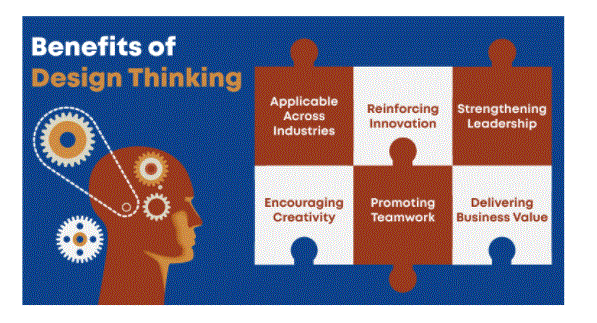
- Design thinking is an iterative and non-linear process. It simply means that the design team continually uses their results to review, question and improve their initial assumptions, understanding and results. The results of the final stage of the preparatory work process inform our understanding of the problem, help us determine the parameters of the problem, enable us to redefine the problem, and, perhaps most importantly, give us new insights. So that we can see alternative solutions that may not be available with our previous level of understanding.
- Tim Brown also emphasises that design thinking techniques and design strategies are related at every level of business. Design thinking is not only for designers but also for creative employees, freelancers and leaders who want to incorporate design thinking into every level of organisation, product or service to drive new choices for business and society.
- Design thinking is essentially a specific problem-solving approach to design, which involves assessing known aspects of a problem and identifying more obscure or peripheral factors that contribute to the conditions of a problem. This is in contrast to a more scientific approach where concrete and known aspects are tested to arrive at a solution.
- Design Thinking is an iterative process in which knowledge is constantly being questioned and acquired so that it can help us redefine a problem in an attempt to identify alternative strategies and solutions that are less than our initial level. With understanding may not be immediately clear. Design thinking is often referred to as ‘outside the box thinking’, as designers are attempting to develop new approaches that do not follow as effective or more common problem-solving methods as artists do. . At the heart of Design Thinking is the intention to improve products by analysing how users interact with them and examining the conditions in which they operate. Design Thinking gives us a means to dig into that depth to uncover ways to improve user experiences.
Conclusion:
